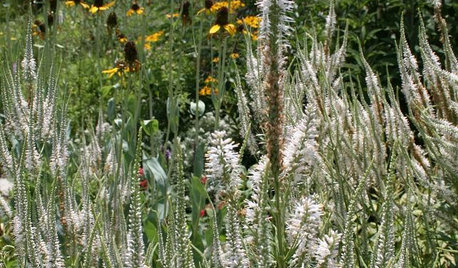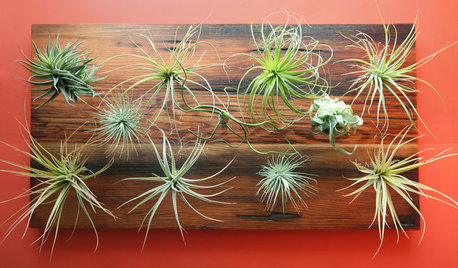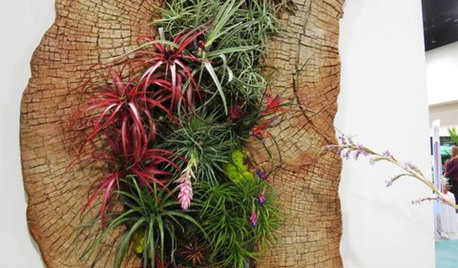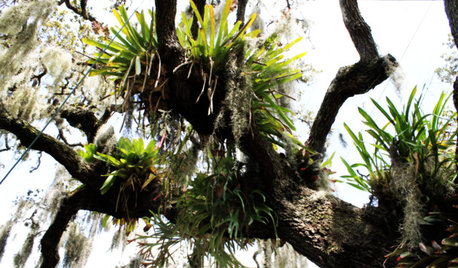Do plants roots really need air?
Hi. I know this sound very stupid but if plants root really need air then why hydroponic is even possible? I mean the plant's root is submerged all the time without air to breathe and the plant still lives. Why is that?
Comments (33)
seysonn
10 years agoActually it is a wise question. Majority of the plants in the nature grow roots deep in the ground and their root bulbs are fully covered. I think , maybe it is the microbes around the roots that need air. Not sure.
Natures_Nature
10 years agoFrom what i understand, the majority of hydroponic setups do not constantly keep the roots submerged.. Instead, they have a timer hooked up to a pump and a reservoir. The timer would kick the pump on, the pump would pump fertilized water to the plants roots, after the plants get a good drink, the water is drained away.. There are so many different hydro setups, im sure some does submerge the roots.. But whenever i see a setup like this, they almost always have a aerator to provide oxygen for the roots..
Also, it's important to note that plants have different roots. Tap roots, aerial roots, fibrous roots, etc.. Often you see multiple roots on one plant. For example, if a plant is not getting enough oxygen in the roots, it makes sense the plants might try and produce aerial roots to absorb some of the oxygen it so desperately needs.
Here is a link that might be useful: Roots, oxygen?
Related Professionals
Camas Landscape Architects & Landscape Designers · Middle River Landscape Architects & Landscape Designers · Wakefield Landscape Contractors · Surprise Landscape Contractors · Brookline Landscape Contractors · Coeur d'Alene Landscape Contractors · Dallas Landscape Contractors · Danvers Landscape Contractors · Farmington Landscape Contractors · Lantana Landscape Contractors · North Chicago Landscape Contractors · Peachtree City Landscape Contractors · West Haverstraw Landscape Contractors · North Aurora Landscape Contractors · Barrington Driveway Installation & Maintenancewayne_5 zone 6a Central Indiana
10 years agoThe soil already contains air with oxygen in it if it isn't water saturated. When water percolates downward, air replaces the water. Think of a straw full of water with your finger over the top end. Unless air replaces the water, the water will not leave the straw. Again think of a gallon jug of water inverted. The water can only leave the jug as air replaces the water.
This post was edited by wayne_5 on Mon, Dec 9, 13 at 12:18
nc_crn
10 years agoMost hydroponic systems "oxygenate" the solution the roots are in via aeration pumps. There's also the exposed aerial roots.
Dissolved oxygen taken up by roots is the easiest way for most pants to obtain oxygen. Oxygen isn't a nutrient (technically), but it is needed to produce almost every vital process in a plant...amino acids, nucleic acids, sugars, proteins, and a bunch of other organic compounds.
Having oxygen around isn't enough...it has to be able to be chemically cleaved for uptake by the plant. H2O contains plenty of oxygen...but it's the total mixed chemical solution in a hydroponic (or soil) solution along with aeration allows the O to "dissolve" and become plant available.
There's also other oxygen contributors such as CO2 (which is taken up a bit by leaves as well as roots), but like most things a plant likes to use for organic processes, it's a lot more effective if the plant can get it through the roots if the chemical makeup of root solution allows it.
ceth_k
Original Author10 years ago@nature:thanks for the info. You said plants might try and produce aerial roots to get more oxygen but isn't getting oxygen the job of leaves? And for certain plants such as lotus which has its root totally submerged most of the time, how can its root not rot? Guess I'll have to do more research on hydroponic to make sure.
@ wayne_5: thank you for your input, but I don't think what you said is somehow relevant to with what we are discussing. This is not exactly about gravitational force of water or anything of the like. Thanks anyway.
shuffles_gw
10 years ago"The Amazon water-lily is able to produce such large and strong structures because it can collect an abundance of food through its roots from the mud at the bottom of the lake. But roots need to breathe and the mud at the bottom of Amazonian swamps and pools contains little or no oxygen. The lily, however, pipes air down to them through tubes running down the long stems of the leaves, which may be as much as 35 feet long." (Attenborough 1995:290-291)
Also:
"In winter, all plants have very slow metabolism due to the low temperatures. Some species of trees have spongy areas in the young bark of the limbs called lenticels allowing oxygen to be obtained from the air. In soils that are not frozen, oxygen diffuses into the soil which is absorbed by the roots of the plants.Aquatic plants can absorb oxygen, carbon dioxide and minerals that are dissolved in the water directly through the cell walls and plasma membranes. Most submerged aquatic plants lack a cuticle on the surface of the leaves and stem. If there are floating leaves (water lily), then the stomata are on the upper surface of the leaves. If roots are present the roots can also absorb these gases and minerals."
Here is a link that might be useful: Source
Natures_Nature
10 years ago" You said plants might try and produce aerial roots to get more oxygen but isn't getting oxygen the job of leaves?"
Im not a plant, i would not know.. Even these scientist who study plants really don't know exactly what's going on and i don't think humans will ever know exactly what's going on with plants.. We know bits and pieces, but we never know everything.. Watch next year, scientist are going to find more plant functions.. Its a never ending process.. What i was saying as if your unnaturally growing, say tomatoes, whereas the roots are completely submerged, the tomatoes aren't adapted to growing in water, so they will try and adapt and do whatever it needs to survive, if that means produce aerial roots so it doesn't suffocate, so be it.. But a water lily or lotus is adapted to growing in water, thats a different story.. Now, whats more effiecient or not, im not sure..
"@nature:thanks for the info. And for certain plants such as lotus which has its root totally submerged most of the time, how can its root not rot? Guess I'll have to do more research on hydroponic to make sure."
Well since we covered the hydroponics already.. Lets cover natural plants growing in the wild, with their roots fully submerged.. In short, Some plants are made to be in water, some plants adapted to water.. This is natural.. Just as fish are in water..
Wayne's comment might not be that relevant to hydroponics,but it is relevant to the title "do plants need air" and the previous post he responded to..
Nc post might be helpful as wellmckenziek
10 years agoI didn't know that plant roots actually need oxygen. Learn something new every day.
I read a book called "Ecology of the planted aquarium" and from what I recall, the roots of the aquatic plants don't actually need oxygen. They are adapted to anoxic conditions. But maybe terrestrial plants are different. I have to assume, the roots of rice, for example, don't need oxygen. There may be oxygen in the water, and in the first inch of mud, but below that, the conditions are certainly anoxic.
But I guess only some plants are adapted for that (maybe that is why wet feet are so harmful to most plants).
--McKenzie
ceth_k
Original Author10 years ago@ mckenziekï¼ That is exactly what intrigued me. I am really starting to think maybe the importance of oxygen and air to plants root is overrated. I now agree more toward the theory that plants root does not actually afraid of waterlogged soil at all like I used to believed.
seysonn
10 years agoIt is logical to think that plants have assigned to duty/work of getting air and light to the part that is in the air and the function of getting food and moisture is given to the root system. If there is any benefit to having air in the soil is for the micro organism that are working on organic mater for plant use.
A botanist and plant biochemist probably knows i a greater detail as what is happening there. There can be some small overlap. That is; as plant leaves can absorb moisture and nutrients, so can root system absorb oxygen.
So it can safely be argued that we do not needs to provide means for oxygen for our potted plants as we don't do that to them in their natural habitat. .
JMPNatures_Nature
10 years ago" I now agree more toward the theory that plants root does not actually afraid of waterlogged soil at all like I used to believed."
Waterlogged soil and low oxygenated soil is a whole different story. We really don't know how much oxygen is actually deep in the soil.. All i know is waterlogged soil is not ideal for most vegetables. Contrary, waterlogged soil kills most plants.
Why don't you do a few simple experiments? Throw a tomato plant(or whatever) in plain water with little oxygen in a bucket, and throw another similar tomato plant in a different bucket with water aerated with a aerator. See what happens.
My guess is that the the tomato with little oxygen is going to get root rot and die first, and the aerated one will take a little more time, but will still die. Why? Tomato's don't natively grow in water, nor without oxygen.. Now if you were to stick a tomato plant in mucky muddy soil, and keep the soil wet, my guess is that will be the first tomato dead, then the one with plain "unoxygenated" water, than the one with the "oxygenated" water..
sunnibel7 Md 7
10 years agoI think the whole misunderstanding is coming from the idea that "air" = "oxygen". It's sort of like asking do fish really need air if they are submerged all the time? And then to compare aquatic plants to terrestial plants is like comparing fish and lizards and deciding you can stick a lizard in an aquarium and it will do fine because fish love it.
Plants need oxygen and carbon dioxide. Those two things are plentiful in our atmosphere as gasses. Aquatic plants also need those things. In a submerged environment those gasses are available in a dissolved form. (But you wouldn't call that dissolved gas "air". They need oxygen but not air.) So aquatic plants lack a tough exterior and tend to be rather thin so that they can readily absorb these dissolved gasses over much of their surfaces (not just the roots). Terrestrial plants have the problem of keeping their cells protected from the drying winds and harsh UV, and there is a lot more O2 and CO2, so they have lots of protection and do their gas absorption in much smaller portions of their anatomy. So terrestrial plants are not the same as aquatic plants. Beyond that, not all roots are the same, even coming out of the same plant. If you've ever rooted a cutting in a jar of water and seen the thick, cylindrical water roots, you know those roots look really different than the roots of that same plant in the dirt. They function different too.
The fundamental lesson: don't try to raise geckos in an aquarium. :)
mckenziek
10 years agoI do know from previous studies (in college) that the oxygen level in ocean, river or lake mud rapidly drops to zero as you go deeper. Dissolved oxygen may be available in the first inch of mud, but not below that. Animals that live and feed in that mud (e.g., aquatic snails and clams) stick siphons up into the water to pull oxygenated water past their gills. Also, we know that the water itself can hold oxygen because fish can live in it. Fish need oxygen. If the water quality is low and it stinks, then probably all the oxygen is used up by decomposition.
digdirt2
10 years agoYou know there are many published scientific research studies available online that address this question. They consistently support the need for O2 for root cell survival and the problems created by anaerobic (overly saturated) soil.
All carbon-based life forms, including plant root cells, require some level of O2 to survive.
Dave
mckenziek
10 years agoDave,
If we are being strictly technical, it is not true that all carbon-based life forms need oxygen. There are organisms which use anaerobic metabolism and therefore do not need oxygen, and there are deep-sea vent organisms which use sulphur as a substitute for oxygen. This is pretty much aerobic metabolism adapted to use sulphur as an alternate oxidizer.
But more importantly, it is one thing to say that root cells need oxygen, and quite another to say that the oxygen must be supplied by the exterior environment immediately near the cells. Plants have transport systems which can distribute nutrients where they are needed. Prior to this thread, I never really thought about whether those transport systems would be capable of moving oxygen downward from the leaves to the roots.
I did do a few simple searches on the topic, but at first I didn't find anything that looked especially credible.
Just now I tried again and found a decent looking article. Link below. According to that article, most terrestrial plants have roots which require oxygen from the environment immediately around the roots. But some marsh or aquatic plants can transport oxygen from the leaves to the roots, and some have adapted to the point where the roots (or maybe the whole plant?) utilizes anaerobic metabolism to grow without oxygen. So there you go.
--McKenzie
Here is a link that might be useful: Adaptations of marsh plants
nc_crn
10 years agoWith all due respect, we're just getting into technicalities when we're talking about water/marsh plants on this issue. There's not many of these plants out there we're going to run into vs terrestrial plants...especially in the realm of veggie gardening...except rice.
Like almost all parts of a plant, roots respirate...aka, "breathe." Not every plant process is taking in CO2 and producing O2...in fact, root respiration is a lot like human respiration in that it takes in O2 and gives off CO2. This is an important part of root health and even those plants that live with roots waterlogged naturally have physical structures designed to keep this process happening.
The CO2 being able to escape/ventilate and provide fresh O2 to the roots is important to many plants. Unless the water is artificially oxygenated and moving (such as in a pump hydroponic system) or there's pore space in the soil to allow gas exchange, roots (and therefore the plant) will suffer.
Plants adapted to live in water-filled soils have structures which allow oxygen movement (and CO2 ventilation) through above-ground structures in their stems, leaves, and roots (aerenchyma tissues).
nc_crn
10 years agoIn case anyone wants a little something more...
Here's what happens when a non-flood adapted herbacious (non tree/shrub) plant in soil becomes water-logged/flooded...
First of all, microbes freak out and start consuming all the available oxygen in a far more effective manner than the plant roots...out-competing roots for that resource.
Toxins and growth-disadvantageous hormones start building up in/around root surfaces as a reaction to the environment both in the soil solution and inside the plant, itself.
Because the plant now has it's internal water pressure system screwed up, stomas on leaves will close and roots will slow-to-halt uptaking more water. This causes a slowed halt to nutrient uptake. Ethylene may also start to develop in the root zone because of the low oxygen available in the roots and a physiological response.
So we have extremely low nutrient uptake, growth hormone imbalances, root and shoot elongation halted...basically the plant is starving itself to death while releasing hormones that will quickly further decline in the plant in a desperate attempt to mature before it dies.
In some plants this will happen very quickly...some are a lot more tolerant.
mckenziek
10 years agoThanks nc. Everything you say makes sense and meshes well with the bits and pieces I already know. Based on what you say, it kind of sounds like roots immersed in water might be OK if you can avoid the anoxic conditions. For example if you have a stream of clean flowing water, roots might be OK in it.
Sorry for bringing up the marsh plants. I was kind of thinking out loud, and going through my recollections of relevant information. I agree it is not relevant in this forum except as a side note.
--McKenzie
ceth_k
Original Author10 years agoHi again. I went and read through all posts in the link below provided by Natures_Nature:
Now I've got a better understanding about plant roots and the importance of oxygen to them. Thank you Natures_Nature, mckenziek, nc-crn and all the others for your revealing info(despite a bit technical which is just great).
zeedman Zone 5 Wisconsin
10 years ago"Here's what happens when a non-flood adapted herbacious (non tree/shrub) plant in soil becomes water-logged/flooded... "
Just to expand on Nc-crn's great comments...
The end process described creates an anaerobic environment in the root zone. At that point, the roots are weakened, and anaerobic pathogens already in the soil will begin to attack them. The normal balance between good & bad organisms has been disrupted. The damage, as Nc-crn mentioned, can occur very quickly.
What I see as one of the the differences between flooding in garden soil, and growing in hydroponics, is the presence of those anaerobic pathogens.
shuffles_gw
10 years agoThis is a bit aside the point, but it is a popular misconception that rice is grown under water. The paddies are flooded a couple or three times. This is partly for irrigation, but mostly for weed control. Rice can stand the harsh, flooded environment longer than most weeds. Only wild rice, which is not rice, is grown under water. I grow rice in a wet spot in my garden. It is almost never flooded.
daninthedirt (USDA 9a, HZ9, CentTX, Sunset z30, Cfa)
10 years agoRe oxygen and roots, it's well established that plants immersed in water to start roots produce roots faster if the water is aerated. You can do that aeration by just stirring the water. Water has dissolved oxygen in it. If it didn't, fish would die. So yes, roots need oxygen, but they don't need to get it by having air blown on them.
Air percolates through just about any soil, so just because you can't breathe if you're buried in soil doesn't mean that roots so buried can't get the oxygen they need. Of course, any water that is sprinkled on the soil will carry oxygen down with it.
I think the problem for water-logged plants doesn't have anything to do with oxygen deprivation but, as noted, with other stuff that thrives in moist conditions.
seysonn
10 years agoThis is not in direct response to any post, but plants needing OXYGEN is different from needing AIR. The latter implies that the roots needs to be aerated, like in some container mixes.. You can have fairly compacted soil(not necessarily water logged) and provide nutrients an water and the plant will grow. A lot of gardeners use plastic mulch that almost prevents aeration , with no problem. Another thing is that it the roots system needed oxygen the leaves can provide it to the roots.
I think the benefit of oxygen in the soil is mostly for the micro organism to do their job.Then, of course, there are different plants that can survive in waterlogged soil with no problem: like onions, mints, water cress, ... I have kept some mints and onion seedlings in a bucket, with a little water in it, for weeks, without ever aerating it.
JMOcharles0358
10 years agoAs people early mentioned it, the soil already contains oxygen so it does need some oxygen
ZachS. z5 Platteville, Colorado
10 years agoFrom the University of California Santa Barbara:
Plants need oxygen for the same reason you and I do -- without oxygen we can't convert the carbohydrates, fats, and proteins we eat into energy. We call this process respiration.
Photosynthesis produces oxygen as a waste product, so for the most part plants don't have to breathe in extra oxygen -- they can just use the oxygen that they produce during photosynthesis. However, plants only perform photosynthesis in the green parts, like leaves and stems, but all plant cells need oxygen to respire. Cells in the leaves get plenty of oxygen from photosynthesis, but cells in the roots often need to get oxygen from the environment to stay alive. Even though roots are buried, they can absorb oxygen from the small air spaces in soil. This is why it's possible to 'drown' plants by watering them too much.
If the soil is way too wet, the roots are smothered, the roots can't get any oxygen from the air, and the cells in the roots die. Without those root cells, the rest of the plant dies. Some plants have evolved adaptations to deal with extremely wet soil. Mangroves are trees that live in swampy environments along the coast in the tropics. The roots of mangroves are often entirely under saltwater, so they have special structures called pneumatophores (Greek for "air carrier") that act like snorkels, sticking up out of the water to get a oxygen for the roots.
mckenziek
10 years agoI thought this thread was dead. That is interesting about the adaptation of the Mangroves.
For anyone interested, make sure you scroll up and read the comments by nc-crn.
--McKenzie
ZachS. z5 Platteville, Colorado
10 years agoI agree that air =/= oxygen. Really, 80% of "air" is elements other then oxygen and oxygen is available in forms other then air. And so we come to your point; oxygen atoms bonded to hydrogen as a water molecule vs. oxygen atoms dissolved in water.
Water is made of hydrogen and oxygen, but we can't breath it even though both hydrogen and oxygen are found in the air we breathe. H20 in and of itself is devoid of oxygen that can be used for cellular respiration of either plants or animals despite it being part of it's chemical makeup.
"Extra" oxygen (in the form of O2) atoms can be dissolved in H2O and not be bonded to other elements (I.e. H) and is thus available for respiration. This is how fish breathe, and how hydroponic systems work.
And here is where I think we disagree:
A lack of O2 dissolved in water will result in fish drowning, as well as roots. A lack of available oxygen prevents cell respiration. Lack of cell respiration means ATP production (which is the energy source used by cells) is halted and without ATP, the cell can not function and it dies. While bacterial "attacks" may play a small part, the fact the cells cannot produce energy in an anaerobic environment is the main cause of death.
Anaerobic fermentation is another way that cells can create ATP, by substituting some other element in place of oxygen. But for the most part, this type of energy production is used by prokaryotes. Fermentation is observed in plants and animals, of course, but it is in very limited situations and is not in general how our cells generate the energy they need to survive.
This post was edited by ZachS on Sat, Mar 8, 14 at 13:33
pls8xx
10 years agoZack is very correct!
And like a lack of water can cause a loss of plant vigor long before it reaches a wilt condition, so too does an oxygen deficiency cause a loss of vigor before any obvious symptoms appear.
Water is saturated with free oxygen at about 10 parts per million. Water can't hold more than that and the oxygen can be depleted very quickly under some conditions if there is no replenishment from an air source.
daninthedirt (USDA 9a, HZ9, CentTX, Sunset z30, Cfa)
10 years agoI'm not sure who you're disagreeing with. Not me. As I said, a lack of aeration in the water will limit the oxygen uptake of roots, just as it will kill fish. My whole point was that such lack of aeration is what you get when you have water stagnating at root depth. Basically, the roots just sitting in an underground puddle. Unless your bed is sitting on concrete, or maybe hardpan, that's not going to happen.
That oxygen is part of water is entirely irrelevant to the discussion. Dissociating the oxygen from the hydrogen is a highly energy intensive process, and that process doesn't happen naturally on Earth. We're not talking about oxygen bonded to hydrogen. O2 dissolved in water isn't "extra" oxygen because it is the ONLY usable oxygen.
I'll say it again. You can "drown" plants just as you can "drown" fish. Takes some bad water, such as water that is very stagnant, but you can do it.
I'll also say it again If you drown plants by putting them in water, hydroponics won't work. Got news for you. It does.
daninthedirt (USDA 9a, HZ9, CentTX, Sunset z30, Cfa)
10 years agoLet me add that hydroponics, when done properly, takes these points into account. Static-culture hydroponics, where the water is just an unstirred tub, requires that the roots be close to the surface. Continuous flow hydroponics is where the mixture flows slowly past the roots. That way, there is circulation, and that circulation guarantees proper aeration. In sufficiently permeable soil, one has the latter, where oxygenated water being sprinkled on the surface makes its way down past the roots. In relatively impermeable soil, the water just collects at depth, and is not aerated.
Hydroponics can actually result in higher yields than regular soil-gardening. That's not going to happen with a drowned plant.
So yes, roots need air, and in good, relatively permeable soil, they get that, at least partly by being watered.
tapla (mid-Michigan, USDA z5b-6a)
10 years agoYes, roots need air (oxygen). Water uptake, and therefore nutrient uptake, are energy driven. In order for the process to occur, plants need to torn the food they make into energy, and that requires oxygen, just as your own body requires oxygen to keep your cells fueled.
The reason many terrestrial plants can be grown in water is by virtue of the fact they can change root structure. The roots produced in water are quite different from those produced in a soil-like or highly aerated medium (perlite - screened Turface - calcined DE - seed starting mix, e.g.). Physiologically, you will find these (water) roots to be much more brittle than normal roots due to a much higher percentage of aerenchyma (a tissue with a greater percentage of intercellular air spaces than normal parenchyma - as in terrestrial plants).
Aerenchyma tissue is filled with airy compartments. It usually forms in already rooted plants as a result of highly selective cell death and dissolution in the root cortex in response to hypoxic conditions in the rhizosphere (root zone). There are 2 types of aerenchymous tissue. One type is formed by cell differentiation and subsequent collapse, and the other type is formed by cell separation without collapse ( as in water-rooted plants). In both cases, the long continuous air spaces allow diffusion of oxygen (and probably ethylene) from the upper part of the plant to roots that would normally be unavailable to plants with roots growing in hypoxic media. In fresh cuttings placed in water, aerenchymous tissue forms due to the same hypoxic conditions w/o cell death & dissolution.
Note too, that under hypoxic (airless - low O2 levels) conditions, ethylene is necessary for aerenchyma to form. This parallels the fact that low oxygen concentrations, as found in water rooting, generally stimulate plants to produce ethylene. For a long while it was believed that high levels of ethylene stimulate adventitious root formation, but lots of recent research proves the reverse to be true. Under hypoxic conditions, like submergence in water, ethylene actually slows down adventitious root formation and elongation.Soggy soils are hard on plants for a couple of reasons. A) Roots can't quickly make back and forth transitions from well-aerated to hypoxic. B) Soggy soils don't allow the roots enough O2 to work efficiently, so root function is impaired or roots die from a lack of O2. C) Gas exchange in soggy soils is poor. O2 diffuses in air about 10,000 times faster than in water, so in transitional situations (aerated to hypoxic) the plant can't get O2 from the soil OR the upper plant organs. Also, since CO2 is heavier than air, soils with poor gas exchange tend to fill with CO2, and hold onto gas byproducts of decomposition - like the CO2 already mentioned, sulfurous gasses, methane ... which is an obvious problem.
Al
ZachS. z5 Platteville, Colorado
10 years agoThen I guess I was merely misunderstanding you. My apologies. Simply putting roots in water is not going to kill them, that's not what I'm saying, and I know that we agree on this point.
Where I think I got misconstrued is the idea that it is bacterial or fungal activity that causes root death, not a lack of oxygen (once again, I may have misinterpreted your statement here, further apologies if I did).

















daninthedirt (USDA 9a, HZ9, CentTX, Sunset z30, Cfa)